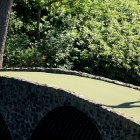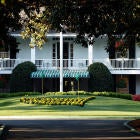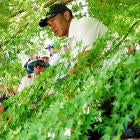
Augusta National is going to look different as viewers tune into the 2022 Masters. Not significantly so as the changes made to the golf course were subtle -- as nearly all adjustments made to the course and the grounds have been over the years -- but it will play differently this year.
If you look closely, you'll see how Augusta National -- as it has always labored to do -- is continuing to modernize and improve its crown jewel of a course. In its recently-released guide for the 2022 Masters, the club made note of some of the changes forthcoming for the 86th edition of its tournament.
Augusta National is the most recognizable golf course in the world because it's in our lives for an entire week every single year. So even subtle changes can be significant to patrons and viewers because we notice them in a way we would not if this was Bay Hill or Congressional. Even more so, these changes will undoubtedly affect the way the 2022 Masters (and those succeeding it) are played. Course strategy will change, decisions will be different than they would have been.
It's all very exciting stuff for the golf nerd and Masters follower, and I can't wait to see how it unfolds here at the first major championship of 2022. Let's take a look at them one by one along with some accompanying satellite footage from the last year.
No. 11 -- White Dogwood
Masters tees moved back 15 yards and to the golfer's left. Fairway recontoured and several trees removed on right side.
This is the first change to No. 11 since the fairway was widened 14 years ago in 2008. However, this was also one of the most predictable adjustments based on satellite footage from the last year. The moving of the tee box is important, but the removal of the trees is more meaningful as it relates to strategy on this hole. Now, golfers have options instead of being forced to hit it up the left side. They can hit it up the right or the left depending on the pin location, which as Andy Johnson points out here, makes for a much more exciting golf hole. Additionally, the bailout area on the right side of the green is lower than it used to be.
"It's a more generous tee shot," said Rory McIlroy this week. "It was always an awkward tee shot. You had to hug that right side, and then if you just got it slightly right, you were in those trees. So the tee shots may be slightly easier, but then it leaves you with a longer second shot in, and I think that's where the hole becomes a lot more difficult.
"The second shot is basically the same. You're maybe going to have 15 or 20 more yards into the green, but the penalty for missing the second shot is greater than it was before. You've got that runoff on the right that, if you get to the middle, like say pin high with the middle of the green, that dropoff on the right side is significantly deeper than it used to be. So the miss really now is short right, sort of front edge, level with front edge of the green and just a little right, but that brings those mounds into play.
... So the penalty for missing that second shot is much greater, and then if you do miss it, obviously it's a very, very difficult up and down from there."
Why yes, of course we do! 😎 “Any shots a little further down 11 fairway to see if they removed all of the trees on the right side of the fairway?” (📸 ©10JUN2021 David Dobbins/EurekaEarth) #EurekaEarth #NotDrone #DiscoverThePresent pic.twitter.com/oBso2wN3HE
— Eureka Earth® (@EurekaEarthPlus) June 16, 2021
No. 15 -- Firethorn
Masters tees moved back 20 yards and fairway recontoured.
Formerly a 530-yard hole, Firethorn will now play 550 yards, which will add some intrigue to whether players can take their second shots over the water in front of the 15th green for a glimpse at eagle with the tournament in the balance on the weekend. That's a thrill, and all of these changes are simply restorations of the strategic integrity with which the golf course was built.
They're necessary in a lot of cases because of how equipment has advanced and eroded some of the risk-reward strategy that makes courses like Augusta National so great. This is probably the change I'm most excited about. You can see it below where there's a sliver cut out between the 10th green and the 11th fairway.
"Then 15 they've extended the tee a little bit," said McIlroy. "Then I feel like they've cambered the fairway a touch more from right to left to sort of have balls feed sort of behind that collection of trees so you maybe have to play a shot with your second if you want to go for the green. It forces you to hit the tee shot up the right-hand side to have a clear view of the green. So the tee shot's a little more demanding"
FLASH: Significant changes coming to No 15 & No 11 at ANGC. Now you didn’t think a little thing like the #USOPEN would prevent our team of photojournalists from reporting breaking news, did you? (📸 ©10JUN2021 David Dobbins/EurekaEarth) #EurekaEarth #NotDrone #DiscoverThePresent pic.twitter.com/6XO3ruBuTq
— Eureka Earth® (@EurekaEarthPlus) June 15, 2021
No. 18 -- Holly
Thirteen yards added to the back of the Masters tees without necessitating a change in length to the hole.
This adjustment is minimal, though I do wish it would have been in place in 2018 when Jordan Spieth was trying to shoot 62 to win the Masters on Sunday over Patrick Reed but made bogey at the last when he clipped a tree off the tee. I'm not sure this changes strategy all that much, though it may alter club selection coming into the 18th green, depending on pin position. This is seemingly the most minimal of the changes, but it will still be interesting to hear what players have to say about it.





















